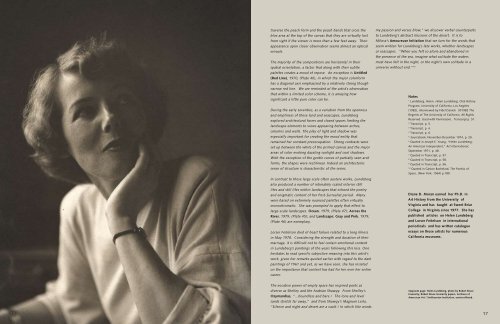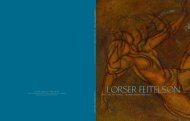helen lundeberg - Louis Stern Fine Arts
helen lundeberg - Louis Stern Fine Arts
helen lundeberg - Louis Stern Fine Arts
Create successful ePaper yourself
Turn your PDF publications into a flip-book with our unique Google optimized e-Paper software.
traverse the peach form and the peach bands that cross the<br />
blue area at the top of the canvas that they are virtually lost<br />
from sight if the viewer is more than a few feet away. Their<br />
appearance upon closer observation seems almost an optical<br />
miracle.<br />
The majority of the compositions are horizontal in their<br />
spatial orientation, a factor that along with their subtle<br />
palettes creates a mood of repose. An exception is Untitled<br />
(Red Line), 1970, (Plate 40), in which the major colorform<br />
has a diagonal axis emphasized by a relatively strong though<br />
narrow red line. We are reminded of the artist’s observation<br />
that within a limited color scheme, it is amazing how<br />
significant a little pure color can be.<br />
During the early seventies, as a variation from the openness<br />
and emptiness of these land and seascapes, Lundeberg<br />
explored architectural forms and closed spaces limiting the<br />
landscape elements to views appearing between arches,<br />
columns and walls. The play of light and shadow was<br />
especially important for creating the mood entity that<br />
remained her constant preoccupation. Strong contrasts were<br />
set up between the white of the primed canvas and the major<br />
areas of color evoking dazzling sunlight and cool shadows.<br />
With the exception of the gentle curves of partially seen arch<br />
forms, the shapes were rectilinear. Indeed an architectonic<br />
sense of structure is characteristic of the series.<br />
In contrast to these large scale often austere works, Lundeberg<br />
also produced a number of intimately scaled interior still<br />
lifes and still lifes within landscapes that echoed the poetry<br />
and enigmatic content of her Post-Surrealist period. Many<br />
were based on extremely nuanced palettes often virtually<br />
monochromatic. She was prompted to apply that effect to<br />
large-scale landscapes. Ocean, 1979, (Plate 47); Across the<br />
River, 1979, (Plate 45); and Landscape: Gray and Pink, 1979,<br />
(Plate 46) are exemplary.<br />
Lorser Feitelson died of heart failure related to a long illness<br />
in May 1978. Considering the strength and duration of their<br />
marriage, it is difficult not to feel certain emotional content<br />
in Lundeberg’s paintings of the years following this loss. One<br />
hesitates to read specific subjective meaning into this artist’s<br />
work, given her remarks quoted earlier with regard to the dark<br />
paintings of 1961 and yet, as we have seen, she has insisted<br />
on the importance that content has had for her over her entire<br />
career.<br />
The eocative power of empty space has inspired poets as<br />
diverse as Shelley and the Arabian Shawqy. From Shelley’s<br />
Ozymandias, “…boundless and bare / The lone and level<br />
sands stretch far away,” and from Shawqy’s Magnum Leila,<br />
“Silence and night and desert are a vault / In which like winds<br />
my passion and verses blow,” we discover verbal counterparts<br />
to Lundeberg’s abstract illusions of the desert. It is to<br />
Milosz’s Amoureuse Initiation that we turn for the words that<br />
seem written for Lundeberg’s late works, whether landscapes<br />
or seascapes. “When you felt so alone and abandoned in<br />
the presence of the sea, imagine what solitude the waters<br />
must have felt in the night, or the night’s own solitude in a<br />
universe without end.” 10<br />
Notes<br />
1 Lundeberg, Helen. Helen Lundeberg. Oral History<br />
Program, University of California, Los Angeles<br />
(1982), interviewed by Fidel Danieli. (©1982 The<br />
Regents of The University of California. All Rights<br />
Reserved. Used with Permission). Transcript p. 51.<br />
2 Transcript, p. 5.<br />
3 Transcript, p. 4.<br />
4 Transcript, p. 6.<br />
5 Sourcebook, November-December 1974, p. 20.<br />
6 Quoted in Joseph E. Young, “Helen Lundeberg:<br />
An American Independent,” Art International,<br />
September 1971, p. 48.<br />
7 Quoted in Transcript, p. 57.<br />
8 Quoted in Transcript, p. 58.<br />
9 Quoted in Transcript, p. 56.<br />
10 Quoted in Gaston Bachelard, The Poetics of<br />
Space, (New York, 1964) p.189.<br />
Diane D. Moran earned her Ph.D. in<br />
Art History from the University of<br />
Virginia and has taught at Sweet Briar<br />
College in Virginia since 1977. She has<br />
published articles on Helen Lundeberg<br />
and Lorser Feitelson in international<br />
periodicals and has written catalogue<br />
essays on those artists for numerous<br />
California museums.<br />
Opposite page: Helen Lundeberg, photo by Robert Bruce<br />
Inverarity, Robert Bruce Inverarity papers, Archives of<br />
Amercican Art / Smithsonian Institution, unmicrofilmed.<br />
16 17





